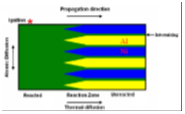|
Other Projects |

|
Home | Contact Us | Research | Publications | People |




|
Self-propagating reaction of nanofilms |
|
Cells keep alive during bonding process |
|
Self-focusing mechanism of SFATs |
|
Cells are lysed locally at focal spot. |

|
Study Galaxy using 3D tactile image |
|
· Reactive multilayer nanofilms contain thousands of nanoscale Al and Ni bilayers. With a small thermal pulse, these films can react exothermically and generate a self-propagating reaction. Self-propagating formation reactions in such films are driven by a reduction in chemical bond energy. This local reduction of chemical bond energy produces a large quantity of heat that is conducted down the foil and facilitates more atomic mixing and compound formation. Such exothermic reactions in multilayer films can be used as local heat sources to melt solders or brazes and thus bond components in a variety of applications. With localized heating, temperature sensitive components such as microelectronic devices can be joined without thermal damage. This bonding process can be performed in many environments, such as in vacuum, and can be completed in a second or less. We have explored bonding wafers with living cells sustained and also using its heat as a micro initiator. X. Qiu, R. Tang, R. Liu, H. Huang S. Guo and H. Yu, “A Micro Initiator Realized by Reactive Ni/Al Nanolaminates”, Journal of Material Science- Material in Electronics, 2012: Volume: 23 Issue: 12 Pages: 2140-2144 DOI: 10.1007/s10854-012-0726-5 (pdf) X. Qiu, D. Welch, J. Christen, J. Zhu, J. Oiler, C. Yu, Z. Wang, and H. Yu, “Reactive Nanolayers for Physiologically Compatible Microsystem Packaging”, Journal of Material Science-Material in Electronics, 2010: v. 21, issue 6, pp: 562-566 (pdf)
· Images are visual content. For this information to become accessible to the blind or visually-impaired, there must be a conversion of a visual image into alternative sensory data. Tactile literacy is critical to enhance the social and physical capabilities of people who are blind, to help them pursue higher levels of education in Science, Technology, Engineering, and Mathematics (STEM) fields and other areas of post-secondary education that require basic STEM literacy, and ultimately obtain professional level employment in STEM or other professional disciplines. Scientists and engineers have been working together at ASU to implement 3D tactile images for class teaching of science and engineering undergraduates. E. Hasper, A. Gonzales, B. Martinez, L. Harris, H. Yu, Z. Farkas, T. Hedgpeth, R.A. Windhorst, and D.P. Baluch, “Methods for creating and evaluating 3D tactile images to teach STEM courses to the visually impaired,” Journal of College Science Teaching. (in press)
· Self-focusing acoustic transducer (FSAT) is based on the concept of constructive interference of acoustic waves. When the transducer is excited with a burst of RF signals, it generates acoustic waves which propagate toward the liquid/air interface. If the electrodes of the transducer are properly designed (Fresnel lens), the acoustic waves will interfere constructively at the focal point, producing a high intensity acoustic beam (directed upward) at the focal point. Accompanying the upward acoustic waves in the liquid are in-plane acoustic waves which are also generated by the transducer. The in-plane waves produce a strong convention flow in the liquid. We have developed SFATs to produce strong acoustic wave lysing the cells on the glass locally (~120um in diameter), driving the device itself owing water flow produced, and high frequency ultrasound imaging tool.
Z. Wang, X. Qiu, J. Zhu, J. Oiler, S.Chen, J.Shi, E. S. Kim, and H. Yu, “Directional Acoustic Underwater Thruster”, IEEE Trans. Ultrason. Ferroelect. Freq. Contr, 2011: Volume: 58 Issue: 6 Pages: 1114-1117 DOI: 10.1109/TUFFC.2011.1918 (pdf) J. Zhu, C. Lee, E.S. Kim, D. Wu, C. Hu, Q. Zhou, K.K. Shung, and H. Yu, “High-overtone Self-Focusing Acoustic Transducers for High Frequency Ultrasonic Doppler”, Ultrasonics, 2011: 50(6):544-7. (http://dx.doi.org/10.1016/j.ultras.2010.02.002) (pdf) C. Y. Lee, W. Pang, S. C. Hill, H. Yu and E. S. Kim, “Airborne Particle Generation Through Acoustic Ejection of Particles-in-droplets”, Aerosol Science and Technology, 2008: Volume: 42 Issue: 10 Pages: 832-841 (PDF) C. Y. Lee, H. Yu, W. Pang, and E. S. Kim, “Droplet-based microreactions with oil encapsulation”, Journal of Microelectromechanical systems, 2008: Volume: 17 Issue: 1 Pages: 147-156 (PDF)
|